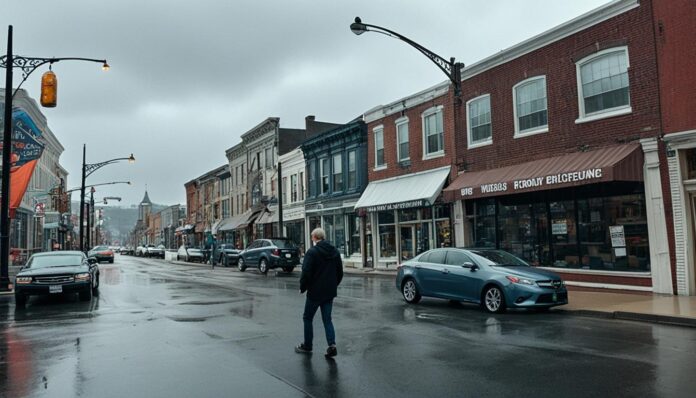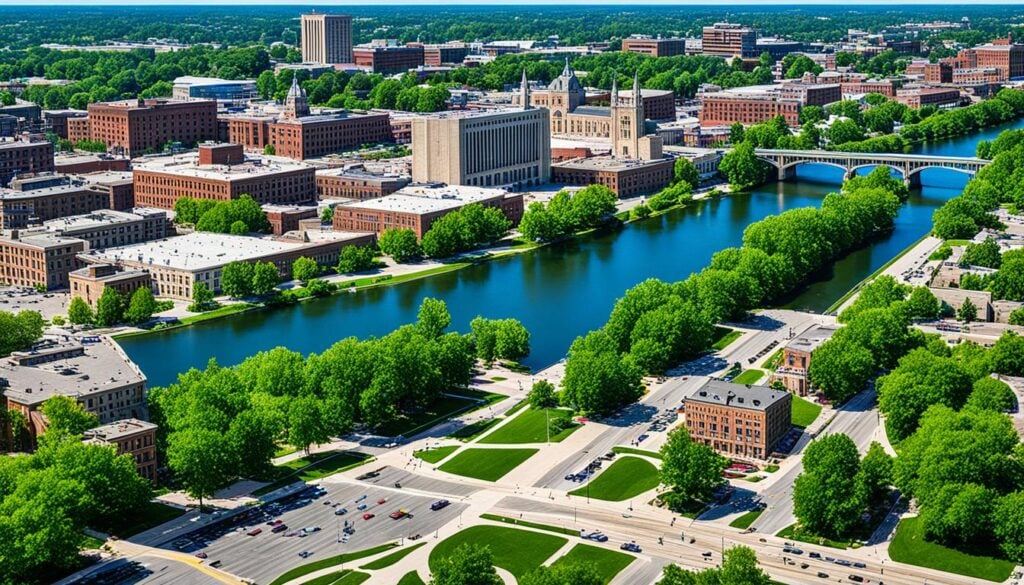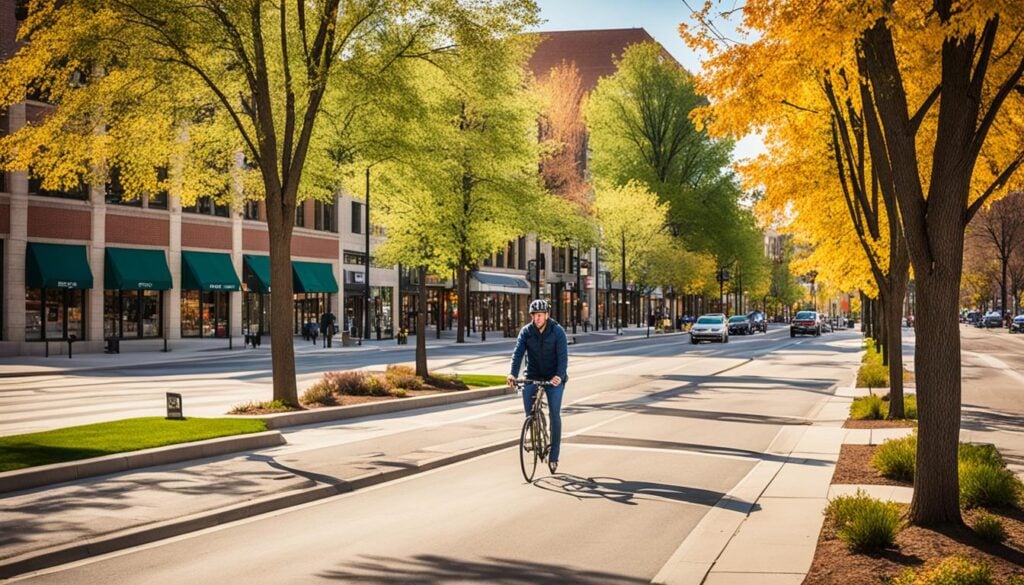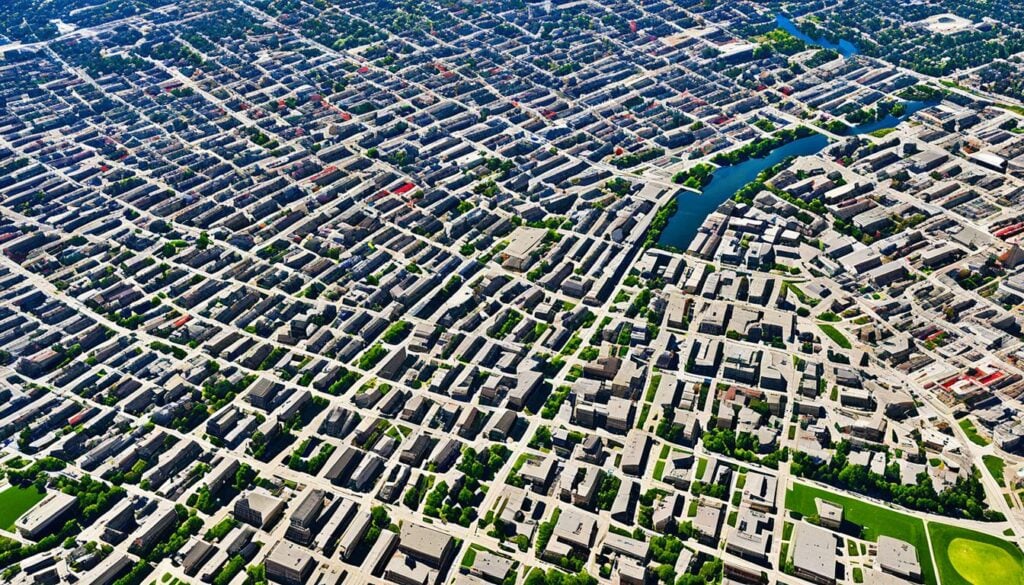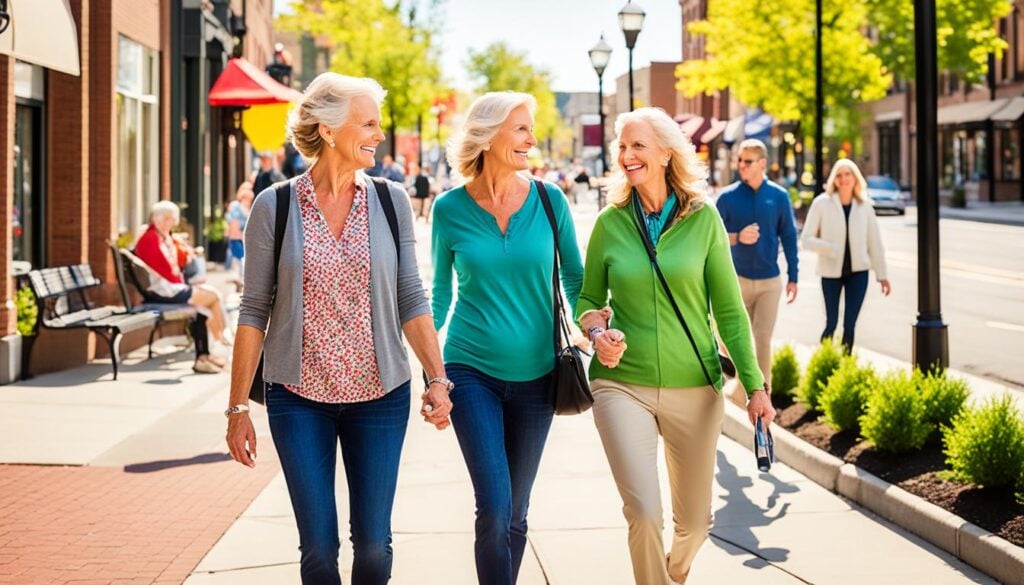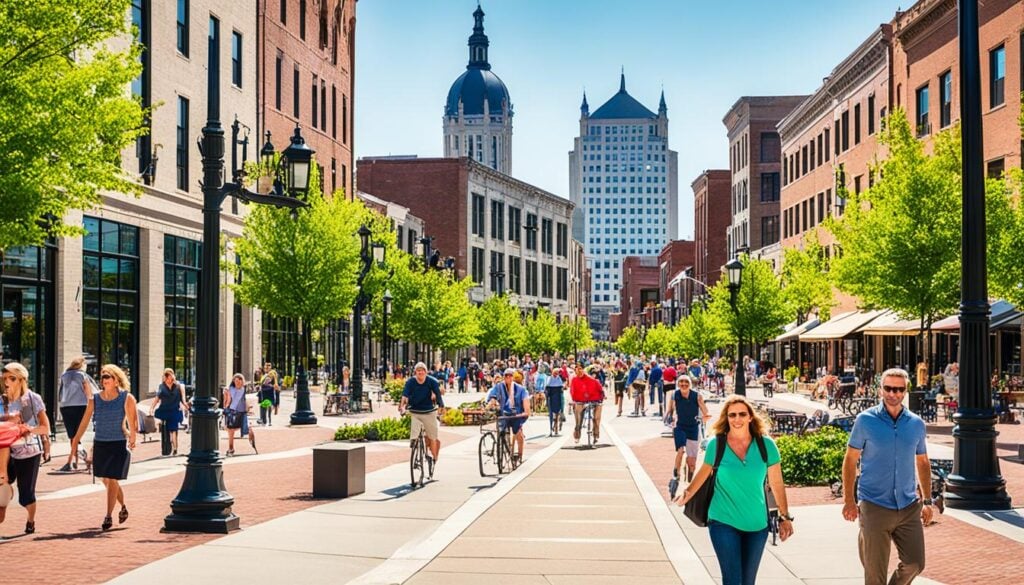When visiting or moving to a new city, walkability is a key factor to consider. It affects your daily life, commute, and overall urban experience. So, Is Toledo, Ohio walkable or do I need a car?
Let’s explore Toledo’s urban landscape and pedestrian infrastructure. We’ll also look at the available transportation options in this Midwestern city.
This information will help you decide if a car is necessary in Toledo. You’ll learn whether you can embrace a more pedestrian-friendly lifestyle here.
Introduction to Toledo’s Urban Landscape
Toledo, a city in northwestern Ohio, boasts a rich history and evolving urban landscape. Its geographic layout and development over time greatly impact the city’s walkability.
Geographical Overview
Toledo sits along Lake Erie’s western shores, with the Maumee River flowing through its center. The city’s flat terrain, with few gentle hills, suits pedestrian-friendly infrastructure and urban planning.
Downtown Toledo is compact, with key attractions close together. As the city grew, suburban areas expanded, creating both opportunities and challenges for walkability.
Historical Context
Toledo’s growth as a transportation hub shaped its urban development. Canals, railroads, and highways led to a sprawling, car-centric layout in some areas.
Recently, there’s been a focus on revitalizing downtown and promoting walkable communities. Historic districts, mixed-use developments, and public transportation investments have shifted Toledo’s urban landscape.
Understanding Toledo’s geography and history provides insights into its walkability. These factors shape the city’s transportation needs and pedestrian-friendly areas.
Evaluating Toledo’s Walkability Score
The walkability score is vital for measuring a city’s pedestrian-friendliness. Toledo’s score reflects how easily residents can navigate on foot. It considers factors that create a walkable urban environment.
Toledo’s overall walkability score is 42 out of 100, according to Walk Score. This puts Toledo in the “car-dependent” category. Most errands here require a personal vehicle.
Similar-sized cities score differently. Akron, Ohio has 48, while Fort Wayne, Indiana scores 39. These numbers show how Toledo compares to its peers.
Several factors influence Toledo’s walkability score. These include sidewalk availability, crosswalk presence, and nearby amenities. Urban planning and design also play crucial roles.
Some Toledo neighborhoods may be more pedestrian-friendly than others. However, the overall score suggests reliance on cars. This raises the question: Is Toledo, Ohio walkable or do I need a car?
| City | Walkability Score | Walkability Rating |
|---|---|---|
| Toledo, Ohio | 42 | Car-dependent |
| Akron, Ohio | 48 | Somewhat walkable |
| Fort Wayne, Indiana | 39 | Car-dependent |
Toledo’s low walkability score highlights a need for improvement. Continued efforts in urban planning and infrastructure are necessary. These changes could create a more pedestrian-friendly environment for residents.
Is Toledo, Ohio walkable or do I need a car?
Toledo’s walkability varies across different areas. Understanding the city’s pedestrian-friendly features can help you decide if a car is necessary. Let’s explore the factors that influence getting around on foot in this Midwest city.
Factors Impacting Walkability
Toledo’s urban design significantly affects its walkability. The city’s land use patterns and pedestrian infrastructure play crucial roles. Well-planned, mixed-use neighborhoods can make walking more inviting.
However, sprawling suburbs often require personal vehicles for daily tasks. The city’s layout determines how easily you can navigate without a car.
Pedestrian Infrastructure
The quality of Toledo’s sidewalks and crosswalks is vital for safe, comfortable walking. A well-connected network of pedestrian amenities enhances neighborhood walkability.
Key features include well-maintained sidewalks, ample crosswalks, and pedestrian signals. Street lighting and traffic calming measures also improve the walking experience.
Dedicated bike lanes and accessible public transportation boost walkability. Pedestrian-friendly amenities like benches and shaded areas can make your daily commute easier.
| Walkability Factor | Toledo’s Performance |
|---|---|
| Urban Design | Mixed, with both walkable and car-centric areas |
| Pedestrian Infrastructure | Improving, with ongoing investments in sidewalks and crosswalks |
| Public Transportation | Limited, with room for expansion of bus routes and frequency |
| Bike Lanes and Trails | Expanding network, but still lacking connectivity in some areas |
Evaluating these factors will help you understand Toledo’s walkability. You can then decide if a car is necessary or if walking is a viable option.
Exploring Neighborhood Walkability
Toledo’s walkability varies greatly across different neighborhoods. The city offers diverse pedestrian experiences, from bustling downtown streets to quieter suburban areas. Let’s explore the unique features of each area.
Downtown Toledo
Downtown Toledo is the city’s vibrant heart. It boasts a high walkability score with well-maintained sidewalks and dedicated crossings. The compact, grid-like layout makes it easy to navigate on foot.
The area features pedestrian-friendly infrastructure like benches and street lighting. These elements enhance the overall walking experience for residents and visitors alike.
Suburban Areas
Toledo’s suburbs present different challenges for pedestrian-friendly commuting. These neighborhoods often have wider streets and larger blocks. They also rely more on personal vehicles, making foot travel less convenient.
However, some suburban communities have improved their walkability. They’ve added sidewalks, bike lanes, and traffic-calming measures. These changes create a more pedestrian-friendly environment.
| Neighborhood | Walkability Score | Pedestrian Infrastructure |
|---|---|---|
| Downtown Toledo | High | Well-maintained sidewalks, dedicated crossings, street lighting, and landscaping |
| Suburban Areas | Moderate to Low | Wider streets, larger blocks, less pedestrian-friendly infrastructure, but some improvements in recent years |
Understanding Toledo’s diverse walkability helps answer the question: Is Toledo, Ohio walkable or do I need a car? Each neighborhood offers unique commuting options. Consider these factors when planning your travels around the city.
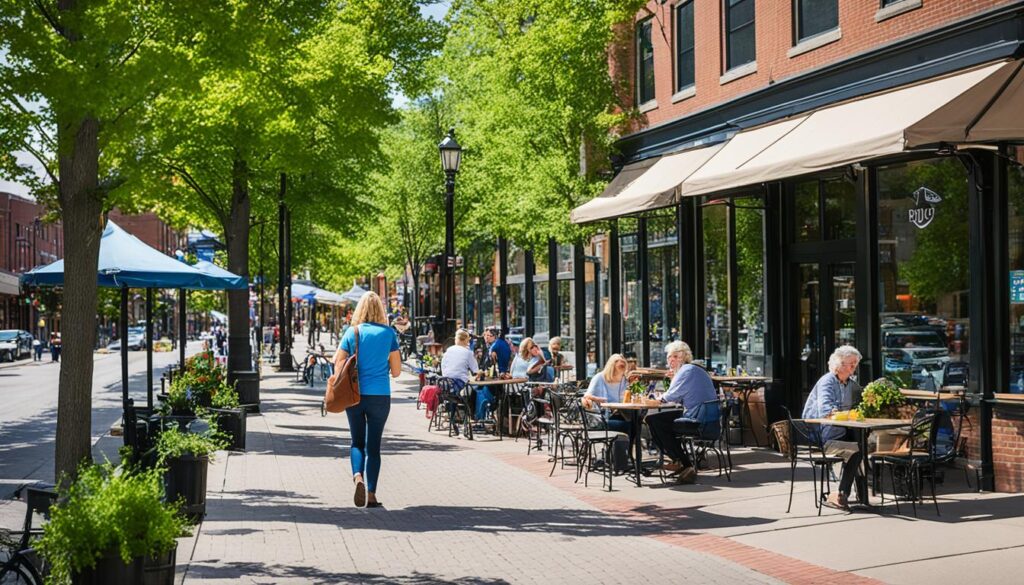
The Role of Urban Planning and Development
Toledo is working to improve its walkability. The city aims to create a pedestrian-friendly environment for everyone. Urban planning plays a crucial role in this transformation.
Complete streets policies are a key initiative. These prioritize all road users, not just cars. As a result, Toledo now has wider sidewalks and dedicated bike lanes.
The downtown area has undergone significant revitalization. Mixed-use development and more residential units have made it more vibrant. Public spaces have also been enhanced, encouraging people to explore on foot.
Planners focus on creating walkable neighborhoods beyond downtown. They use zoning regulations and strategic investments. This ensures residential areas and commercial districts are well-connected for pedestrians.
Despite progress, challenges remain in Toledo’s walkability efforts. Some areas lack continuous sidewalks. Suburban neighborhoods need better pedestrian infrastructure. Balancing different transportation modes is also an ongoing issue.
Urban planning is vital for Toledo’s walkability goals. By focusing on pedestrian-friendly initiatives, the city is evolving. It’s becoming more livable, sustainable, and fair for all residents.
Transportation Options in Toledo
Toledo, Ohio offers various transportation choices. The public transit system shapes the urban landscape. It determines if residents and visitors need cars to move around easily.
Public Transit System
The Toledo Area Regional Transit Authority (TARTA) manages Toledo’s public transportation. TARTA provides buses, paratransit services, and a downtown shuttle. The bus network covers a wide area, connecting the city center with suburban neighborhoods.
TARTA’s bus routes serve commuters, linking major employment hubs and shopping areas. The system offers discounted fares for students, seniors, and disabled individuals. This makes public transit accessible and affordable for diverse pedestrian-friendly travelers.
Toledo’s public transit is generally reliable and accessible. However, some routes may have limited frequency and coverage. This is especially true in suburban areas.
These limitations can challenge those relying solely on public transportation. Some situations might require using a personal vehicle for commuting and transportation needs.
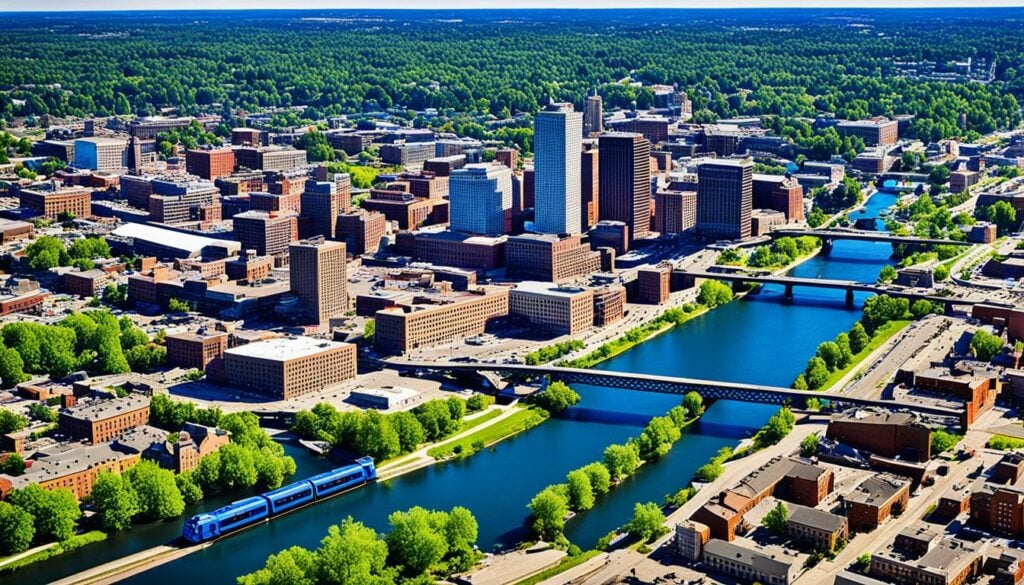
City officials and transit authorities aim to improve Toledo’s walkability and urban planning. They focus on enhancing the public transit system’s efficiency and connectivity. These efforts can make Toledo more pedestrian-friendly and promote sustainable transportation options.
Benefits of Walkable Communities
Toledo’s focus on walkability can bring numerous advantages to its residents. Pedestrian-friendly areas offer a wide range of benefits that can greatly improve life in the city.
Health and Environmental Advantages
A walkable Toledo promotes better health and a cleaner environment. Walking regularly improves heart health, helps manage weight, and boosts overall wellness.
Less car use means fewer greenhouse gases and cleaner air. This creates a more sustainable urban landscape for everyone to enjoy.
- Improved cardiovascular health and fitness
- Reduced risk of obesity and chronic diseases
- Decreased air pollution and carbon footprint
- Smaller environmental impact from reduced vehicle use
Economic and Social Impacts
Walkable communities boost Toledo’s economy and social life. Easy access to local shops and services helps businesses thrive and creates a strong sense of community.
Studies show that pedestrian-friendly areas attract new residents and businesses. This can drive economic growth and investment in the city.
| Economic Benefits | Social Impacts |
|---|---|
| Increased foot traffic and sales for local businesses | Stronger sense of community and social cohesion |
| Attracting new residents and businesses to the area | Improved accessibility for all community members |
| Potential increase in property values | Enhanced opportunities for social interaction and recreation |
Prioritizing walkability in Toledo can unlock many benefits for its residents. It improves quality of life, promotes sustainable development, and creates a more vibrant community.
“Walkable communities are not just about convenience; they are about creating more livable, sustainable, and equitable cities.”
Challenges and Opportunities
Toledo aims to be more walkable, facing unique challenges and opportunities. Understanding these factors is vital for shaping pedestrian-friendly urban planning. This vision requires careful consideration of existing obstacles and potential solutions.
Toledo’s main obstacle is its car-centric infrastructure. Outdated roads, missing sidewalks, and few pedestrian crossings make walking difficult. Overcoming these barriers needs significant investment and long-term dedication to walkability and urban planning.
Yet, Toledo can use its assets to create a pedestrian-friendly environment. The downtown area offers chances to boost connectivity and improve commuting options. By focusing on these strengths, Toledo can become a model for Is Toledo, Ohio walkable or do I need a car? communities.
- Modernize infrastructure to support pedestrian accessibility
- Explore innovative public-private partnerships to fund walkability initiatives
- Engage with local communities to identify and address their unique walkability concerns
- Promote educational campaigns to raise awareness and encourage a cultural shift towards active transportation
| Challenge | Opportunity |
|---|---|
| Outdated infrastructure designed for automobiles | Leverage existing downtown assets to enhance connectivity and walkability |
| Lack of funding for walkability initiatives | Explore public-private partnerships to finance necessary improvements |
| Resistance to cultural shift towards active transportation | Engage with local communities and raise awareness of the benefits of walkability |
Toledo can become a model for Is Toledo, Ohio walkable or do I need a car? communities. By tackling challenges and seizing opportunities, the city will enhance life quality for residents and visitors alike.
Conclusion
Toledo’s walkability is a mixed bag. The city has improved pedestrian infrastructure but remains largely car-dependent. Its urban landscape offers both opportunities and challenges for walkable lifestyles.
Your transportation needs will determine if Toledo suits you. The city may not meet expectations if you prefer walking everywhere. However, ongoing improvements could make Toledo more pedestrian-friendly in the future.
Your decision to live in Toledo depends on your priorities. Consider your lifestyle and adaptability to the city’s transportation options. Explore diverse neighborhoods and available transit choices to make an informed decision.

































